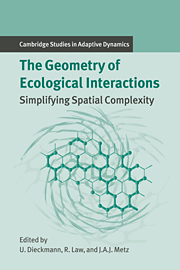Book contents
- Frontmatter
- Contents
- Contributing Authors
- 1 Introduction
- Part A Empirical and Statistical Background: A Plant Ecological Perspective
- Part B When the Mean-field Approximation Breaks Down
- Introduction to Part B
- 6 Grid-based Models as Tools for Ecological Research
- 7 Coexistence of Replicators in Prebiotic Evolution
- 8 Games on Grids
- 9 The Interplay between Reaction and Diffusion
- 10 Spirals and Spots: Novel Evolutionary Phenomena through Spatial Self-structuring
- 11 The Role of Space in Reducing Predator–Prey Cycles
- Part C Simplifying Spatial Complexity: Examples
- Part D Simplifying Spatial Complexity: Techniques
- References
- Index
- International Institute for Applied Systems Analysis
Introduction to Part B
Published online by Cambridge University Press: 14 January 2010
- Frontmatter
- Contents
- Contributing Authors
- 1 Introduction
- Part A Empirical and Statistical Background: A Plant Ecological Perspective
- Part B When the Mean-field Approximation Breaks Down
- Introduction to Part B
- 6 Grid-based Models as Tools for Ecological Research
- 7 Coexistence of Replicators in Prebiotic Evolution
- 8 Games on Grids
- 9 The Interplay between Reaction and Diffusion
- 10 Spirals and Spots: Novel Evolutionary Phenomena through Spatial Self-structuring
- 11 The Role of Space in Reducing Predator–Prey Cycles
- Part C Simplifying Spatial Complexity: Examples
- Part D Simplifying Spatial Complexity: Techniques
- References
- Index
- International Institute for Applied Systems Analysis
Summary
Part B of the book turns from the field to models of ecological processes in spatially structured environments. We hope eventually for a seamless transition from field-based rules of interaction among neighboring plants and animals to computer simulations. The results given in Chapter 3 illustrate how far plant ecologists have gotten in the field, and Chapter 6 shows what theorists can do by listening carefully to ecologists. But at the present state of the art, most models, while motivated by ecological and evolutionary phenomena, are based on assumptions about spatial processes in nature. From study of these models, there is a clear and exciting message: new phenomena, unexpected from mean-field models, are very often evident.
Why should spatially extended models of population and community dynamics differ so much from their mean-field counterparts? A major reason is the existence of spatial variation in local environments. As Part A emphasizes, organisms very often interact with their neighbors, and it is the density of these neighbors that matters, not the density averaged over some large spatial region. Deviations of local neighborhoods from the global average are of two kinds: systematic and random.
Systematic deviations often arise from previous interactions between neighbors. For example, if individuals of species A and B interact antagonistically and reproduce locally, fewer individuals of A will be found around those of B than expected from their global densities (and vice versa). Such deviations are described by local correlations, and dealing with them becomes a major theme later in the book (Chapters 13, 14, and 18 to 21).
[…]
- Type
- Chapter
- Information
- The Geometry of Ecological InteractionsSimplifying Spatial Complexity, pp. 90 - 93Publisher: Cambridge University PressPrint publication year: 2000



